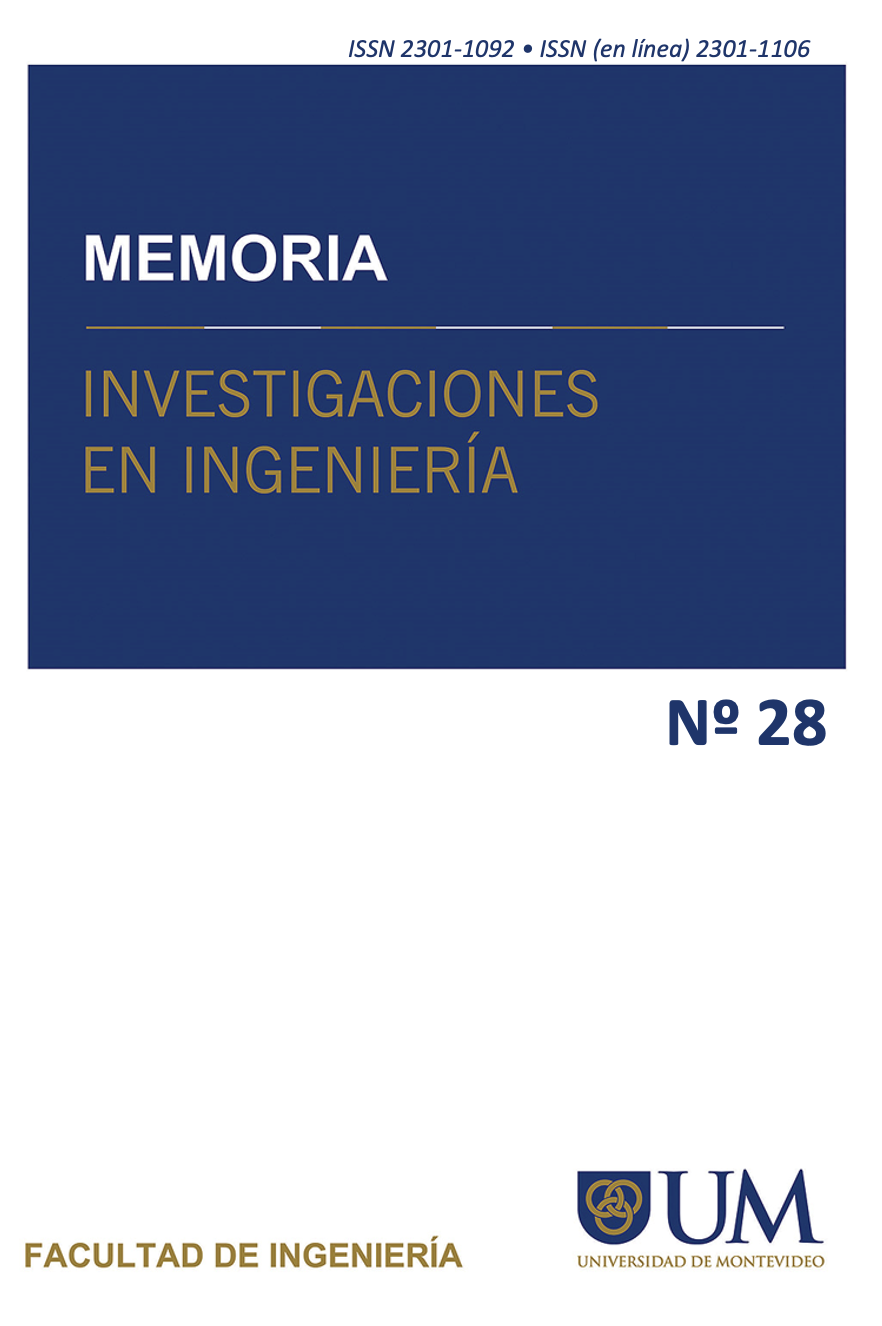Diseño de un sistema de intercomunicación de emergencia vehicular utilizando circuitos electrónicos y sensores
DOI:
https://doi.org/10.36561/ING.28.8Palabras clave:
Intercomunicador de vehículos, Emergencia de tráfico, Prevención de colisiones, Seguridad del vehículoResumen
En el presente trabajo se ha diseñado un sistema de intercomunicadores de emergencia vehiculares, enfocado a mejorar la seguridad de los motociclistas mediante la integración de circuitos electrónicos y sensores. Se utiliza un microcontrolador Arduino UNO R3, módulos SIM900L GSM y sensores ultrasónicos y de proximidad, el sistema está programado en C++ para detectar caídas y activar alertas automáticas con alta eficiencia.
Las caídas se pueden detectar con un 95% de precisión y en un rango de 2 a 100 cm, con un tiempo de respuesta promedio de 1,2 segundos, lo que lo hace adecuado para emergencias. También se destacó la capacidad del sistema para enviar alertas rápidamente, lo que aumenta la seguridad del usuario en situaciones críticas que van desde los 101 hasta los 150 cm. Sin embargo, se identificaron limitaciones en el rango de detección, especialmente a distancias mínimas que oscilan entre 0,02 cm y 1,96 cm, y distancias máximas que oscilan entre 151,36 cm y 177,72 cm, mediciones que están fuera del rango de operación, lo que sugiere la necesidad de realizar más ajustes en el futuro. Este proyecto ofrece una solución innovadora, eficiente y fácil de implementar para mejorar la seguridad vial, con un alto grado de sensibilidad para optimizar la respuesta a emergencias.
Descargas
Citas
M. A. Espinoza-Mina and A. M. Colina-Vargas, “Characterization of traffic accidents for urban road safety,” Revista Facultad de Ingeniería Universidad de Antioquia, Nov. 2023, https://doi.org/10.17533/udea.redin.20231134
A. Carreras-Coch, J. Navarro, C. Sans, and A. Zaballos, “Communication Technologies in Emergency Situations,” Apr. 01, 2022, MDPI. https://doi.org/10.3390/electronics11071155
M. J. Islam, M. N. Pathan, A. Sultana, and A. Rahman, “An IoT-Based Smart Helmet for Riding Security and Emergency Notification,” in Proceedings - 6th International Conference on Electrical Engineering and Information and Communication Technology, ICEEICT 2024, Institute of Electrical and Electronics Engineers Inc., 2024, pp. 1211–1216. https://doi.org/10.1109/ICEEICT62016.2024.10534489
R. Subramaniyan, S. Kumuran, and J. Kathirvelan, “Smart Helmet System with Wireless Communication through GSM,” in 2024 3rd International Conference on Artificial Intelligence for Internet of Things, AIIoT 2024, Institute of Electrical and Electronics Engineers Inc., 2024. https://doi.org/10.1109/AIIoT58432.2024.10574693
S. Goswami, S. Chakraborty, S. Laha, and A. Dhar, “Enhancement of GSM Security using elliptic curve cryptography algorithm,” in Proceedings - 3rd International Conference on Intelligent Systems Modelling and Simulation, ISMS 2012, 2012, pp. 639–644. https://doi.org/10.1109/ISMS.2012.137
G. M. Debele and X. Qian, “AUTOMATIC ROOM TEMPERATURE CONTROL SYSTEM USING ARDUINO UNO R3 AND DHT11 SENSOR,” 2020.
H. J. Santillán Carranza, J. O. Enríquez Sandoval, and J. F. Bonilla Castro, "Development of a Wireless Educational Tool Based on Raspberry Pi," INGENUITY, vol. 7, no. 1, pp. 13–22, Feb. 2024, https://doi.org/10.29166/ingenio.v7i1.5630
B. MertArduino in CircuitsArduino, “Arduino-Ultrasonic Sensor HC-SR04 With Buzzer Introduction: Arduino-Ultrasonic Sensor HC-SR04 With Buzzer.” [Online]. Available: https://www.instructables.com/Arduino-Ultrasonic-Sensor-HC-SR04-With-Buzzer/
C. Vidal-Silva, M. I. Lineros, G. E. Uribe, and C. J. Olmos, “Electronics for everybody using Arduino: Positive experience in the implementation of hardware-software solutions,” Technological Information, vol. 30, no. 6, pp. 377–386, 2019, https://doi.org/10.4067/S0718-07642019000600377
J. A. Marín-Marín, P. A. García-Tudela, and P. Duo-Terrón, “Computational thinking and programming with Arduino in education: A systematic review for secondary education,” Heliyon, vol. 10, no. 8, p. e29177, Apr. 2024, https://doi.org/10.1016/J.HELIYON.2024.E29177
H. Santillán, A. Mantilla, D. Cárdenas, and P. Wong, “Design of a low-cost portable electrocardiograph for telemedicine application,” Engineering Research Report, no. 26, pp. 244–264, Jul. 2024, https://doi.org/10.36561/ing.26.15
M. Nayak and A. K. Dass, “GSM and Arduino based Smart Home Safety and Security System,” https://doi.org/10.5281/zenodo.7610756
P. Jacko et al., “Remote IoT Education Laboratory for Microcontrollers Based on the STM32 Chips,” Sensors, vol. 22, no. 4, Feb. 2022, https://doi.org/10.3390/s22041440
Arulkumar V., Kavin F., Arulkumar D., and Bharathiraja N., “IoT Sensor Data Retrieval and Analysis in Cloud Environments for Enhanced Power Management,” Journal of Advanced Research in Applied Sciences and Engineering Technology, vol. 45, no. 2, pp. 202–213, May 2024.
A. M. Laukkanen, J. Horáček, and V. Radolf, “Buzzer versus water resistance phonation used in voice therapy. Results obtained with physical modeling,” Biomed Signal Process Control, vol. 66, p. 102417, Apr. 2021, https://doi.org/10.1016/J.BSPC.2021.102417
M. P. Valente and I. B. De Paula, “Sensor based on piezo buzzers for simultaneous measurement of fluid viscosity and density,” Measurement, vol. 152, p. 107308, Feb. 2020, https://doi.org/10.1016/J.MEASUREMENT.2019.107308
A. V. Rojas, J. G. Ibarra, A. Y. Nagano, and F. H. B. Santana, "Curing depth of pit and fissure sealants using diode (LED) emitted light at different distances," Mexican Dental Journal, vol. 19, no. 2, pp. 76–80, Apr. 2015, https://doi.org/10.1016/J.RODMEX.2015.05.002
N. Babu Thomas, L. P. Kumar, J. James, and N. A. George, “Trends, progress and future directions of nanomaterial-based sensors: a bibliometric overview,” May 06, 2024, Emerald Publishing. https://doi.org/10.1108/SR-09-2023-0466
M. Fernandez, C. Rodriguez, L. Alonso, and P. J. Oria, "Study of the Influence of Horn Geometry on Radiation Axis Gain of Ultrasonic Sensors in Air," Ibero-American Journal of Automation and Industrial Informatics RIAIVol. 10 No. 4 pp. 441–452, OCT. 2013.
R. Ceres, J. M. Martín, L. Calderón, T. Freire Bastos, and M. Armada, “Environment recognition in welding processes by ultrasonic sensors,” Sens Actuators A Phys, vol. 37–38, no. C, pp. 635–638, Jun. 1993, https://doi.org/10.1016/0924-4247(93)80108-S
L. F. Macea-Mercado, L. Morales, and L. G. Márquez-Díaz, "A Pavement Management System Based on New Technologies for Developing Countries," Engineering, Research and TechnologyVol. 17 No. 2 pp. 223–236, APR. 2016.
N.-P. Ricardo Francisco, "The crest factor trend helps to detect nascent events; electronic circuit, programs, and applications to signals from various fields," Engineering, Research and Technology, vol. 15, no. 1, pp. 63–81, Jan. 2014, https://doi.org/10.1016/S1405-7743(15)30007-X
M. Lohakan and C. Seetao, “Large-scale experiment in STEM education for high school students using artificial intelligence kit based on computer vision and Python,” Heliyon, Vol. 10, No. 10, p. A31366, May 2024.
L. F. Macea-Mercado, L. Morales, and L. G. Márquez-Díaz, "A Pavement Management System Based on New Technologies for Developing Countries," Engineering, Research and TechnologyVol. 17 No. 2 pp. 223–236, APR. 2016.
C. Hurtado, G. Licea, M. García-Valdez, A. Quezada, and M. Castañón-Puga, “Teaching computer programming as a well-defined domain for beginners with protoboard,” in Advances in Intelligent Systems and Computing, Springer, 2020, pp. 262–271. https://doi.org/10.1007/978-3-030-45691-7_25
A. Y. F. Zhu, “Optimizing financial decision-making for emerging adults: A compact Python-based personalized financial projection approach,” Technol Soc, vol. 77, p. 102599, Jun. 2024, https://doi.org/10.1016/J.TECHSOC.2024.102599
M. Lohakan and C. Seetao, “Large-scale experiment in STEM education for high school students using artificial intelligence kit based on computer vision and Python,” Heliyon, Vol. 10, No. 10, p. A31366, May 2024.























